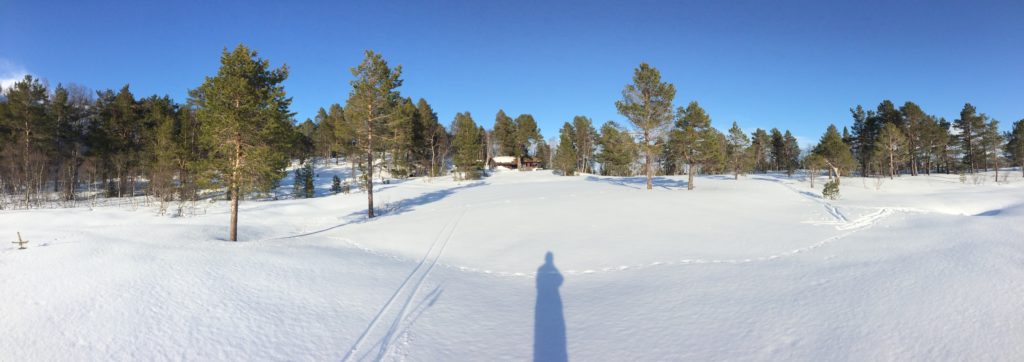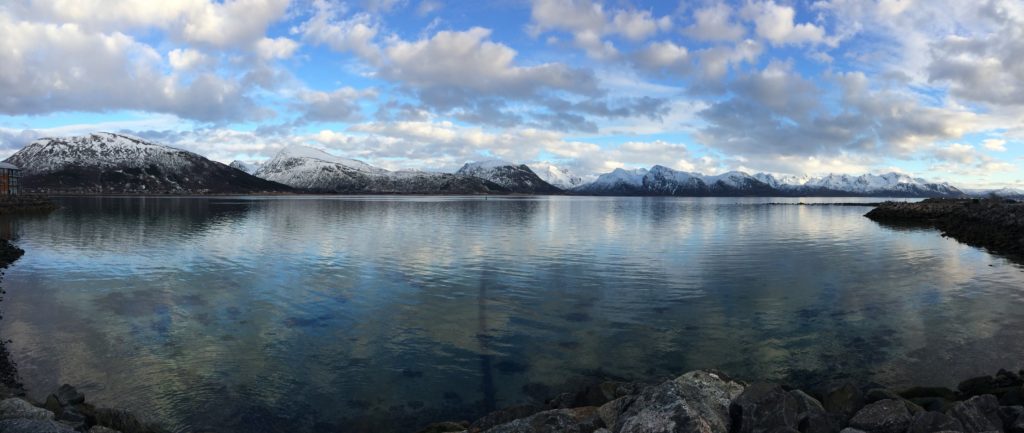I write this at a koselig bar called Apotekergaarden, The Apothecary’s Shop, in Grimstad, a postcard-worthy Norwegian town along the Skagerrak in Southern Norway. Henrik Ibsen wrote his first work here while he trained to become a pharmacist. I arrived last evening in lovely spring weather—the air was soft and still, the water lapped kindly upon the piers and quays, and long, wispy clouds were lit well by the late-setting sun, hanging in the endless Norwegian spring twilight. I woke this morning to the sound—the sound—of heavy snow dropping on the windowsill of my hotel room, and trudged through several centimeters worth of slush on the way to the school I was visiting. It wasn’t snow that fell in the night, but slush itself, prefabricated in the cloud-factories and slopped into market, jamming up roads and ways (spring weather lulls the overexcited people out of their winter- and into their summer-tires). Teachers and students alike were caught in jams of packed slush-ice and traffic. It is April in Norway. It is indeed the cruellest month.
Above my desk back at The Northwest School in Seattle I usually hang a few spring poems, including a Gerard Manley Hopkins’ paean to the vernal burst of life, but at the moment, Edna St. Vincent Millay’s sharp-tongued rebuttal to the most cliched of seasons seems more acute and aptest:
To what purpose, April, do you return again?
Beauty is not enough.
You can no longer quiet me with the redness
Of little leaves opening stickily.
I know what I know.
The sun is hot on my neck as I observe
The spikes of the crocus.
The smell of the earth is good.
It is apparent that there is no death.
But what does that signify?
Not only under ground are the brains of men
Eaten by maggots.
Life in itself
Is nothing,
An empty cup, a flight of uncarpeted stairs.
It is not enough that yearly, down this hill,
April
Comes like an idiot, babbling and strewing flowers.
Oh, I love that poem! And how well it fits the host of contraditions, the blend (and imagine, here, a blender, grinding up a puree, rather than, say, a finely selected blend tea leaves—though that, I think, passes equally well) of feelings turning my heart as I approach the last months, and my calendar begins to run thin of school-visits, and I turn my mind, with a certain twinge in my neck, toward the homeplace I love, and consider the experience of leaving. Av og til føler jeg meg som den samme slags idiot, som skravler og strør blomster landet rundt. Og snart må jeg forlate landet sjølv.
The weeks since I wrote last have been (predictably) full. In there, påska happened—the Easter holiday. Despite Norway’s very secular society (even before the church was finally split from the state in 2012), its holidays are oriented around the church calendar (which is, for its part, of course, oriented around various pagan events, namely solstices). As with jul, most Norwegians get påske off. A good week of vacation, during which the folk drar til hytta, head to the cabin. Strange and wonderful traditions accompany this moment of rebirth. The very same chocolates, sold in red packaging at Christmas, get rebranded and repackaged in yellow as Easter goods. And the nation becomes briefly obsessesed with påskekrim: Easter crime series on TV (!?). I became good ‘n hooked myself, I happily confess. But out at the cabin, which often means (as it should) no television, the presumable last pangs of winter are satisfied. Sola har snudd—the sun has turned (or, rather, we have), and the days become quickly longer, but up at the hytte, it’s likely there’s yet plenty of snow, so a ski-tour or two (or several, or as many as possible in the run of a week) are in order, if not lawfully obligatory. I, lucky pig (heldiggris in Norwegian, their version of “lucky dog”), spent påske at the cabin with relatives in Rindal kommune in the highlands below Trollheimen in Møre og Romsdal. I hauled my skis on the train up to Trondheim through Gudbrandsdalen (a gorgeous ride), in part because in order to get to their cabin at all in March, you’ve got to gå på ski. I had also the distinct joy of having to fetch water (å hente vann) at the spring every day . . . on skis. The spring lies some two meters under the snow, so to get water, one skis to the snow-hole, climbs down, fills the 10-liter jug, and hauls it in a backpack back to the hytte. Three, four trips is enough for a day. Few things generate as much simple pleasure as such a task, though I recognize well that that pleasure emerges from the complex fact that I don’t really have to fetch water to survive. Simple pleasures are seldom simple. (When I taught writing at the University of Washington, I used to say to students that while it’s often tempting to follow Occam’s Razor, that “all things being equal, the simplest explanation is usually the right one,” the problem is that all things are almost never equal.) Still, I cannot deny the particular joy of fetching water. On skis. I’m awfully thankful for those days with Norwegian family, skiing by day, playing games and having conversations by night, with a little sitting silently in the spring sun woven in to the pattern—a healthful pause, some rest, in the midst of a wildly magical and truly wonderfully exhausting year of work.
The week after påske, I headed north again, that earth-deep magnet whose pull I cannot resist, for a week-long to Sortland in Vesterålen, the archipelago north of Lofoten, followed by several days in Bardufoss, in inner Troms, and a couple days in Lillehammer. Vesterålen is less commonly celebrated outside of Norway than its dramatic neighbor to the south, but it is as impressive in its way. Given the lengthening hours of sunlight, I was able to take some very fine solo hikes to the mountain tops surrounding Sortland. The snow remained deep and dreadful in some places, but the crust was largely supportive of my walking (the Norwegians have a good word for crust: skare). Fine, fine feelings in those islands, plus a whole lot of Northern Norwegian. With apologies to my southern-Norwegian friends and family, I admit that nord-norsk is the dialect I’ve grown partial to. The sea is in it. And the sea wind, as I’ve written before. I was swim in it as much as I’m able.
After a full week in Sortland, and a lovely dinner and conversation with one of my hosts, an Englishman who’s lived in Northern Norway for many years, and who learned Norweigan in the north, and so speaks Northern-Norwegian (a little mouse of jealousy crept up in me), I caught the coastal steamer, Hurtigruten, in Stokmarknes and sailed to Finnsnes, where I took a bus to Bardufoss (I was lucky to get passage on the M/S Lofoten, the oldest ship in the Hurtigrute fleet. A beautiful, classic boat, and a welcome remedy to the gargantuans that make up the rest.) Back in Trondheim the week before, I thought I’d had my last ski of the year. But Winter lives long in the inland north. I stayed at Bardufosstun, a regional athletics center with a hotel, and luxurious access to ski trails and skis to rent at very reasonable cost. My itchy legs couldn’t be quieted, so I “walked on skis” for a good 30 km from Bardufoss to Kampenhytta and back, with a nice chat and warm-up in the last kilometer in a lavvo (tepee) along the trail, cared for by the Bardufoss area retirees’ sports association. There is a whole lot of life in the far north.
And so again to Lillehammer, the last direct connection my family has to Norway. I’ve said before that I feel good feelings in Lillehammer, feelings that are doubtless half-invented, but invention is a spirited activity, with the right heart, and I feel reasonably right about Lillehammer. With a couple days, and a little finer-grained sense of things, I sought out what information I could about my family during my visit. Using an old photograph of my great-great-grandfather’s grave as a guide (see below), I sought out the place in the cemetary at Lillehammer Church where he was buried. No stone to be found (no one there to pay for it). So I made my way to the Lillehammer church office in another part of town. I found help there, and the record keeper opened the safe and eventually tracked down the original register of burials for 1906. And there, as the 38th burial that year, stood his name: Gustav Hansen, died on November 6, and buried November 21. He was buried alongside an unrelated child named Karen, who likely lived only some days or hours. The folks at the office told me that that was a relatively common practice for “free graves” in those days—after an infant death, they would wait until the first adult burial in a “free” grave, and lay the child there. This likely means that my family didn’t have much money, which also suggests a good reason for Magnus Albert (my great-great-grandfather) and Emil, Gustav’s two eldest sons, to try their hands in America1, and for the rest of the family to follow later that year. How strange to see that name, once my family’s, written in such fine handwriting by a person who had at least some knowledge of the moment, who may have known (and almost certainly spoke to) my great-grandfather who crossed the Atlantic with little knowledge of what awaited and likely a whole lot of hope. I’m about to make that same journey again, albeit under very different circumstances and by very different means. Still, there will be an uprooting, a heaving-ho, and a sort of leap back in to a sound I know, and though the water has surely shifted while I’ve been away, I suspect I’ll recognize it well.
Meanwhile, I am still here, in Norway. Grimstad represents the 60th school I’ve visited this year (plus or minus a couple), and the 18th of Norway’s 19 fylker, or counties. I fly tomorrow to Bodø, my last working visit to Northern Norway this year. The knot of energy I’ll cary there is palpable, and in the best way. I’ve spent more than forty days above the Arctic Circle this year, and surely—at least I like to imagine—that orientation toward the Earth’s magnetic field has had some effect on the orientation of my own magnetic sensibilities, my forhold to the ground, my balance.
Though they change quickly, the seasons in Norway are long, they merge and knit into one another. Half of spring is still winter, half of summer is spring. I step, still, into the world a little further yet, as it swings toward the sun.
And so, as ever, some images.

Historical photograph of the burial place of my great-great-grandfather, Gustav Hansen, at Lillehammer Church, 1906.

My reproduction of the same (with phone camera), Lillehammer Kirke, 2016. This has to be the general area . . .

BONUS: Lysefjord from just below Preikestolen, in cloud and snow and hail. Old and dear friend Adam visited last week and we trekked up that hill, and well.
1I’ve also recently learned, at last, a little more about my great-grandmother’s lineage. Albert, in Wisconsin, married a woman named Cora Jerdee, whose father, Amund Jerdee, was the son of Ingrid Njøs Gjerde and Peder Larsson Gjerde, who married in 1843 in Leikanger kommune in Sogn og Fjordane, and emigrated to Wisconsin the next year, eventually Americanizing their name to Jerdee from Gjerde. Another project looms . . .





